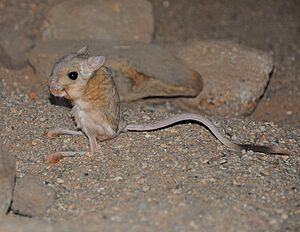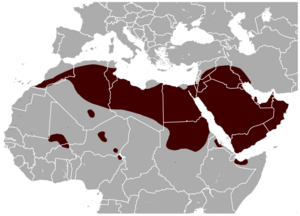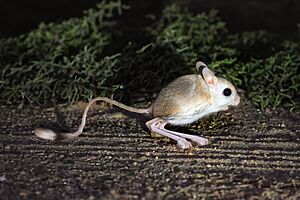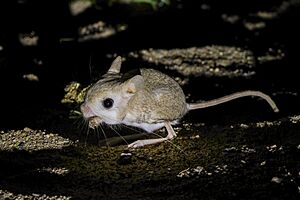Lesser Egyptian jerboa facts for kids
Quick facts for kids Lesser Egyptian jerboa |
|
|---|---|
 |
|
| Conservation status | |
| Scientific classification | |
| Genus: |
Jaculus
|
| Species: |
jaculus
|
 |
|
| Lesser Egyptian jerboa range. | |
| Synonyms | |
|
Mus jaculus Linnaeus, 1758 |
|
The lesser Egyptian jerboa (Jaculus jaculus) is a small rodent that lives in parts of Africa and the Middle East. It's known for its amazing hopping skills! This little animal mainly eats seeds and different types of grasses.
Contents
What is a Lesser Egyptian Jerboa?
This small rodent is sometimes compared to a tiny kangaroo. This is because it has very large back legs. It uses these legs to hop around. The lesser Egyptian jerboa has three toes on each back foot. It also has a very long tail. This tail helps it keep balance when it jumps.
Jerboas have big eyes and ears. Their snout is quite short. Their fur can be a pale or dark sandy color. Their belly is usually a lighter shade.
Jerboa Life and Habits
The lesser Egyptian jerboa is a nocturnal animal. This means it is active mostly at night. It searches for food when it's dark. Its diet includes seeds, insects, and juicy parts of desert grasses. It also eats desert truffles, which are a type of fungus. The jerboa finds these foods using its excellent sense of smell.
Amazingly, this animal does not need to drink water. It gets all the water it needs from its food. This helps it survive in the dry desert. A jerboa can travel long distances to find food. It can cover up to ten kilometers (about six miles) in one night. Its big feet and hopping style help it do this. A jerboa can even leap up to three meters (about ten feet) in a single jump!
Jerboa Homes: Burrows
Lesser Egyptian jerboas live in burrows. They dig these homes using their front paws and teeth. The burrows often spiral counter-clockwise. Permanent burrows can be very complex. They have many entrances and exits. Inside, there are special rooms. These include storage areas, places for sleeping in winter, and a nesting chamber. The nesting chamber is usually at the very bottom.
Jerboas hide their burrows well. In late spring and summer, they seal the entrance with sand. This keeps the heat out and moisture in. The burrow is a perfect place for the jerboa to rest. It also helps them hide from predators. It protects them from the hot desert sun. Sometimes, jerboas also shelter under desert truffles.
During very hot or dry times, the jerboa will aestivate. This is like a summer sleep inside its burrow. In winter, some jerboas might hibernate. This means they go into a deep sleep. However, this has only been seen in a few jerboas.
Reproduction and Young Jerboas
Not much is known about how jerboas breed. This is because they are shy and active at night. But we do know they breed at least twice a year. This happens between June and July, and again from October to December.
Male jerboas try to attract females with a special dance. The male stands on his back legs in front of a female. Then, he gently slaps her with his short front paws. If they mate, the female usually has four or five babies. The young jerboas become independent at about eight to ten weeks old. They can have their own babies when they are eight to twelve months old.
Lesser Egyptian jerboas are usually quiet. But if they are scared or handled, they can make grunting noises. They might also let out shrill shrieks.
Where Jerboas Live
The lesser Egyptian jerboa is found across the Sahara Desert. It also lives in scattered areas of the Sahel. You can also find them in parts of the Middle East.
Jerboa Habitat
These jerboas live in desert areas. These areas can be sandy or rocky. They prefer places where they can dig their burrows easily.





